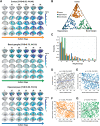Identification of different MRI atrophy progression trajectories in epilepsy by subtype and stage inference
- PMID: 37807084
- PMCID: PMC10629797
- DOI: 10.1093/brain/awad284
Identification of different MRI atrophy progression trajectories in epilepsy by subtype and stage inference
Abstract
Artificial intelligence (AI)-based tools are widely employed, but their use for diagnosis and prognosis of neurological disorders is still evolving. Here we analyse a cross-sectional multicentre structural MRI dataset of 696 people with epilepsy and 118 control subjects. We use an innovative machine-learning algorithm, Subtype and Stage Inference, to develop a novel data-driven disease taxonomy, whereby epilepsy subtypes correspond to distinct patterns of spatiotemporal progression of brain atrophy.In a discovery cohort of 814 individuals, we identify two subtypes common to focal and idiopathic generalized epilepsies, characterized by progression of grey matter atrophy driven by the cortex or the basal ganglia. A third subtype, only detected in focal epilepsies, was characterized by hippocampal atrophy. We corroborate external validity via an independent cohort of 254 people and confirm that the basal ganglia subtype is associated with the most severe epilepsy.Our findings suggest fundamental processes underlying the progression of epilepsy-related brain atrophy. We deliver a novel MRI- and AI-guided epilepsy taxonomy, which could be used for individualized prognostics and targeted therapeutics.
Keywords: MRI; brain atrophy; disease progression; epilepsy; subtype and stage inference.
© The Author(s) 2023. Published by Oxford University Press on behalf of the Guarantors of Brain.
Conflict of interest statement
The authors report no competing interests.
Figures





Comment in
-
Out of one, how many? Subtyping in epilepsy.Brain. 2023 Nov 2;146(11):4411-4413. doi: 10.1093/brain/awad354. Brain. 2023. PMID: 37823432 Free PMC article.
-
Chronicles of Change: The Shrinking Brain in Epilepsy.Epilepsy Curr. 2024 Feb 6;24(3):159-161. doi: 10.1177/15357597241228475. eCollection 2024 May-Jun. Epilepsy Curr. 2024. PMID: 38898902 Free PMC article. No abstract available.
References
-
- Devinsky O, Vezzani A, O'Brien TJ, et al. Epilepsy. Nat Rev Dis Primers. 2018;4:18024. - PubMed
-
- Fisher RS, Cross JH, French JA, et al. Operational classification of seizure types by the international league against epilepsy: Position paper of the ILAE commission for classification and terminology. Epilepsia. 2017;58:522–530. - PubMed
-
- Hirsch E, French J, Scheffer IE, et al. ILAE Definition of the idiopathic generalized epilepsy syndromes: Position statement by the ILAE task force on nosology and definitions. Epilepsia. 2022;63:1475–1499. - PubMed
-
- Thijs RD, Surges R, O’Brien TJ, Sander JW. Epilepsy in adults. Lancet. 2019;393:689–701. - PubMed

